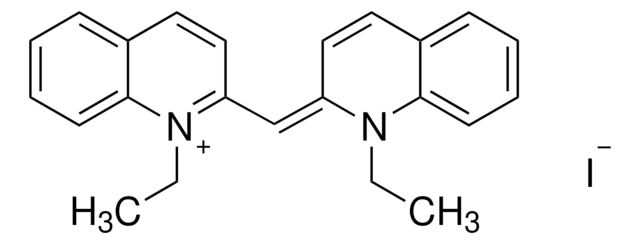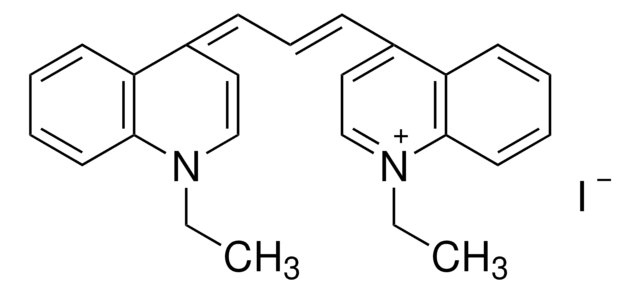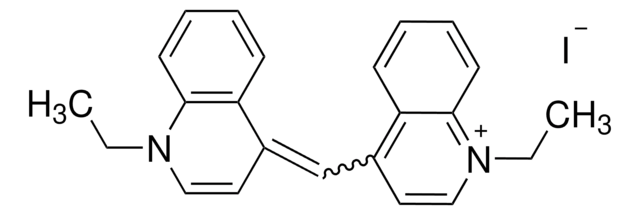381306
3,3′-Diethylthiatricarbocyanine iodide
99%
Sinônimo(s):
3-Ethyl-2-[7-(3-ethyl-2-benzothiazolinylidene)-1,3,5-heptatrienyl]benzothiazolium iodide, DTTC iodide, DTTCI, DiSC2(7)
About This Item
Produtos recomendados
Ensaio
99%
pf
211 °C (dec.) (lit.)
λmax
765 nm
cadeia de caracteres SMILES
[I-].CCN1\C(Sc2ccccc12)=C\C=C\C=C\C=C\c3sc4ccccc4[n+]3CC
InChI
1S/C25H25N2S2.HI/c1-3-26-20-14-10-12-16-22(20)28-24(26)18-8-6-5-7-9-19-25-27(4-2)21-15-11-13-17-23(21)29-25;/h5-19H,3-4H2,1-2H3;1H/q+1;/p-1
chave InChI
OYVFJKVYVDYPFV-UHFFFAOYSA-M
Procurando produtos similares? Visita Guia de comparação de produtos
Categorias relacionadas
Aplicação
Palavra indicadora
Warning
Frases de perigo
Declarações de precaução
Classificações de perigo
Acute Tox. 4 Dermal - Acute Tox. 4 Inhalation - Acute Tox. 4 Oral - Eye Irrit. 2 - Skin Irrit. 2 - STOT SE 3
Órgãos-alvo
Respiratory system
Código de classe de armazenamento
11 - Combustible Solids
Classe de risco de água (WGK)
WGK 3
Ponto de fulgor (°F)
Not applicable
Ponto de fulgor (°C)
Not applicable
Equipamento de proteção individual
dust mask type N95 (US), Eyeshields, Gloves
Escolha uma das versões mais recentes:
Já possui este produto?
Encontre a documentação dos produtos que você adquiriu recentemente na biblioteca de documentos.
Os clientes também visualizaram
Artigos
Graphene has emerged as the new wonder material. Being only one atom thick and composed of carbon atoms arranged in a hexagonal honeycomb lattice structure, the interest in this material has exploded exponentially since 2004 when it was first isolated and identified using a very simple method.
Nossa equipe de cientistas tem experiência em todas as áreas de pesquisa, incluindo Life Sciences, ciência de materiais, síntese química, cromatografia, química analítica e muitas outras.
Entre em contato com a assistência técnica










